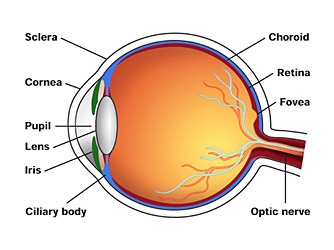MODULE: Anatomy of the eye
Step 02 of 07: Overview
The human eye sees by absorbing light into photo-receptive cells and conveying this information up the optic nerve to the visual cortex of the brain, where it is processed differently given the person's memories and visual experiences.

Light reflected off surfaces in the environment is passed through the cornea and lens, where it is focused into a sharp image, and absorbed by cells that line the back wall of the eye, the retina. These cells are called photo receptors because they respond to light based on their function. They come in broadly two categories: Rods and Cones. Rods are highly sensitive to light, but unable to capture fine detail, they are most useful in low-light settings such as at night. Cones are less sensitive and can tolerate more light making them good for capturing detail and are used more during daylight. Cones also come in three types, as currently verified, which are sensitive to different wavelengths which means they are primarily responsible for differentiating between colours. Colour is simply a difference in the frequency of the light being absorbed. We delve further into the causes of colour in the Module: Colour Perception. There is a blind spot where the optic nerve exits the eye and where no photo-receptor can line.